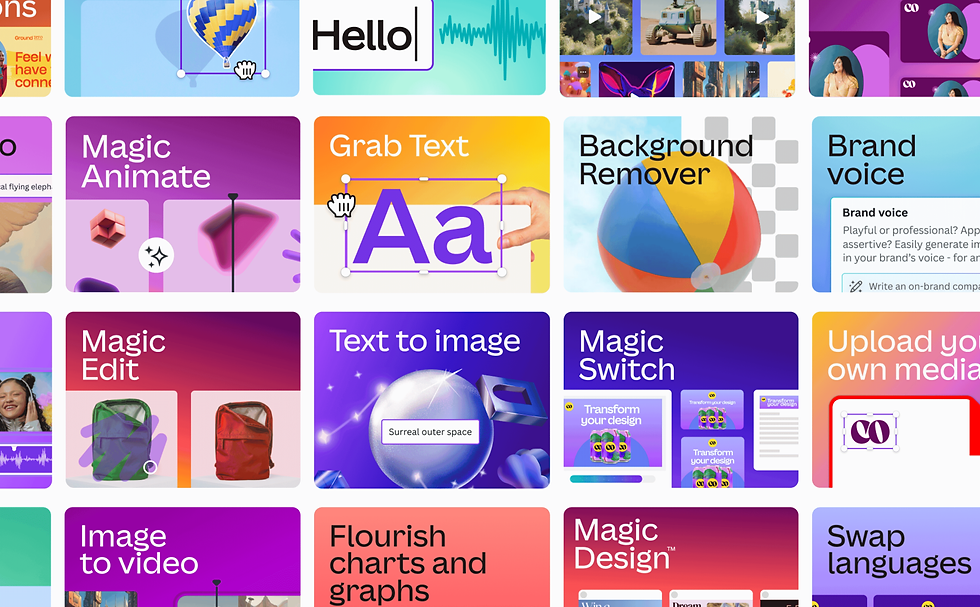Why a Canva Template Can Never Replace Talent
- rbninquiries
- 25 mei
- 3 minuten om te lezen
Why a Template Can Never Replace Talent: The Real Role of Canva in the World of Graphic Design
Canva has made a splash in the world of design. Its drag-and-drop interface, vast library of templates, and ready-to-use elements have turned it into a go-to tool for startups, students, marketers, and even busy executives who need to create visuals on the fly. It seems like anyone can be a designer now, right? That idea has sparked debate. If tools like Canva can produce decent designs so quickly, what happens to the graphic design profession?
Let’s be clear: Canva is a useful tool. It democratizes design by giving non-designers the ability to create visual content. But replacing graphic designers? That is a much bigger leap than it may seem. There are several fundamental reasons why Canva, for all its strengths, does not and will not replace professional graphic design jobs.

Design Is More Than Decoration
One of the biggest misconceptions about design is that it is only about how something looks. In reality, design is a form of communication. A skilled designer considers how layout, color, typography, and imagery all work together to deliver a message. These choices are never random. They are rooted in brand strategy, audience behavior, psychology, and cultural context. Canva offers tools to make things look polished, but it does not offer strategic thinking.
Templates Can’t Tell Your Story
The strength of a brand lies in its uniqueness. A professional designer helps organizations craft a visual language that tells their story across every touchpoint. Canva, by contrast, offers templates that are used by millions. Even with customization, the result often feels generic. A graphic designer builds something original that reflects a brand’s values, tone, and goals. Canva helps you remix existing styles. Designers help you create your own.
Problem Solving Can’t Be Automated
Graphic design is not a one-size-fits-all process. It involves understanding the client's needs, identifying problems, and developing visual solutions. Whether it is improving user experience on a website or creating a campaign that resonates emotionally, designers are constantly analyzing and refining. Canva can help execute a visual idea, but it does not participate in the discovery or problem-solving phase. It follows instructions. Designers ask the important questions first.
Customization Comes With Constraints
Canva is powerful for what it is. But it operates within a fixed system. Fonts are limited. Layouts follow a grid. Interactions with images and vector shapes are simplified. These limitations are what make the tool so easy to use—but they also limit how far you can push creative boundaries. Designers working with professional software like Adobe Illustrator, InDesign, or Figma are not bound by those same constraints. They can create anything from scratch.
Collaboration and Feedback Drive Better Results
Designers are not solo operators. They work closely with clients, stakeholders, writers, developers, and marketers to deliver designs that serve broader goals. Feedback loops are essential to this process. A designer knows how to interpret vague client input, defend choices when needed, and evolve a concept without losing its core purpose. Canva offers no such dialogue. It is a silent partner in a process that often requires conversation, nuance, and flexibility.
Design Is a Profession, Not Just a Skill
Just because a tool is easy to use does not mean it can replace a trained professional. You can learn how to use Canva in a few hours. But learning design takes years of practice, critique, experimentation, and study. Professional designers draw from deep knowledge of visual principles, branding systems, cultural trends, and production processes. That depth can’t be packaged into a template.

So What Is Canva Really Good For?
Canva shines when speed, simplicity, and convenience matter. It is perfect for creating internal presentations, social media updates, or quick promotional flyers. It empowers people to take care of small design tasks without needing to hire someone. It is also a fantastic collaborative tool for teams who want to iterate together or prototype ideas quickly.
In fact, many professional designers use Canva themselves. They may create branded templates for clients to update in-house, or they might use it for rapid drafts. The tool is not the enemy, it is just another part of the evolving design landscape.
Conclusion: The Tool Is Not the Talent
Tools like Canva are not killing design. They are reshaping it. They raise the bar for simple, fast content. But they also make the value of great design more visible. When everyone can produce visuals, the difference between good and truly great becomes even clearer.
Graphic design is not going anywhere. In a world saturated with content, the ability to create something original, purposeful, and memorable has never been more important. Canva is a brilliant tool—but it is not a designer. And it never will be.

.png)


